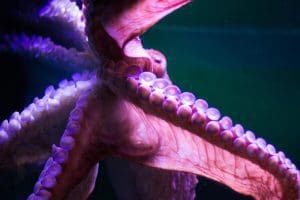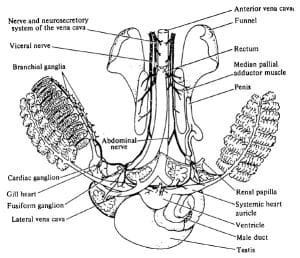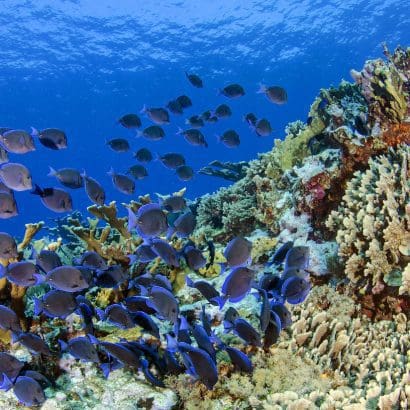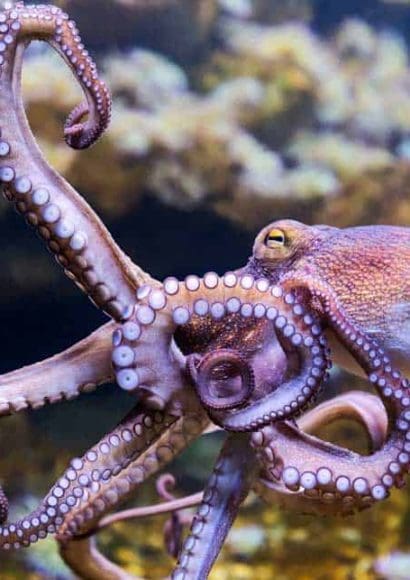
Octopuses, these enigmatic and captivating creatures of the ocean, have always intrigued and fascinated both scientists and nature enthusiasts alike. Their otherworldly appearance, with their bulbous heads, trailing tentacles, and mesmerizing ability to change color and texture, makes them one of the most peculiar and intriguing animals on Earth. From their remarkable intelligence and problem-solving abilities to their unique hunting techniques, octopuses have earned a reputation as the masters of disguise and adaptation.
In this article, we delve into the curious anatomy of octopuses, exploring the intriguing features that set them apart from other marine life. We will journey into the depths of their ocean habitat, examining the structure of their bodies, the complexity of their nervous system, and the marvels of their respiratory and circulatory systems.
Contents
Octopuses and Their Habitat.🐟
Octopuses are fascinating marine animals that belong to the class Cephalopoda. They are part of a diverse group of mollusks, known for their highly developed intelligence and remarkable adaptability. With their soft bodies and eight arms, which are adorned with suckers, octopuses exhibit a captivating appearance that sets them apart from most other sea creatures. These remarkable cephalopods can be found in various oceans around the world, inhabiting a wide range of marine environments.
Description of Octopuses as Marine Animals and their Geographical Distribution:
Octopuses are exclusively marine creatures, which means they inhabit saltwater environments. They can be found in oceans worldwide, from warm tropical waters to cooler temperate regions. Their distribution extends across the Atlantic, Pacific, and Indian Oceans, showcasing their adaptability to a wide range of conditions.
Different species of octopuses have adapted to specific regions, and their geographical distribution varies accordingly. Some species are commonly found along rocky shorelines and coral reefs, while others prefer sandy or muddy bottoms. Certain octopus species are known to inhabit shallower coastal waters, while others can be found at significant depths, even reaching extreme depths of up to several thousand meters in the ocean.
Preferred Habitats and Adaptations:
Octopuses are remarkably adaptable and have evolved to thrive in diverse habitats. They exhibit a strong preference for specific environments based on their species and ecological requirements. Some of the most common habitats preferred by octopuses include:
- Rocky Reefs: Many octopus species are well-suited to rocky reef environments, where they can take advantage of crevices and holes for shelter and protection. The rocky substrate provides them with plenty of hiding places and opportunities for hunting small marine organisms.
- Coral Reefs: Certain octopuses inhabit coral reefs, making use of the complex reef structures to hide from predators and ambush their prey. The coral reefs’ intricate formations provide a rich hunting ground with abundant marine life.
- Sandy or Muddy Substrates: Other octopus species prefer sandy or muddy bottoms. They utilize their extraordinary camouflage abilities to blend into the surroundings and avoid detection by predators and prey alike.
- Deep Ocean Environments: Some octopuses have adapted to life in the deep ocean, surviving in conditions with minimal light and extreme pressures. These deep-sea octopuses have unique adaptations to cope with the challenges of their environment.
Octopuses exhibit behavioral and physical adaptations that enable them to thrive in these diverse habitats. Their soft bodies allow them to squeeze into narrow crevices for protection, and their camouflage abilities help them remain hidden from predators and improve their chances of successful hunting. Additionally, their remarkable intelligence and problem-solving skills aid them in foraging for food and avoiding danger in their ever-changing marine environment.
General Body Structure.🐟
The body structure of octopuses is a marvel of evolution, allowing these intelligent marine creatures to thrive in their diverse ocean habitats. Their unique anatomy, consisting of a distinct head, mantle, and trailing tentacles, distinguishes them from most other animals in the ocean. Understanding the general body structure of octopuses is essential to appreciate their incredible abilities and adaptability.
Description of the Basic Body Form of Octopuses:
- Head: The head of an octopus is the central part of its body and houses the majority of its sensory organs and brain. It is characterized by large, expressive eyes that provide the octopus with excellent vision. The eyes enable the creature to detect movement, differentiate colors, and navigate its surroundings. In addition to their keen eyesight, some octopus species possess specialized light-sensitive cells in their skin, allowing them to sense changes in ambient light levels.
- Mantle: The mantle is a soft, sac-like structure that encompasses the head and vital organs of the octopus. It is the main part of the body responsible for respiration, circulation, and digestion. Within the mantle, a unique feature known as the siphon assists in propulsion by expelling water in rapid bursts, enabling the octopus to move swiftly in the water.
- Tentacles: Octopuses are renowned for their long, flexible tentacles, typically numbering eight, which extend from the sides of their heads. Each tentacle is lined with numerous powerful suckers, allowing the octopus to grasp and manipulate objects with remarkable precision. The tentacles play a crucial role in hunting, catching prey, and exploring the surrounding environment.
Details about the Skin of Octopuses and their Camouflage Abilities:
The skin of octopuses is one of their most extraordinary features, possessing remarkable adaptability and camouflage capabilities:
Changing Color:
Octopuses have specialized pigment cells called chromatophores embedded in their skin. These chromatophores can expand or contract, altering the colors and patterns of the octopus’s skin. This ability allows them to match the surrounding environment, creating intricate camouflage patterns that help them blend seamlessly with rocks, corals, and sandy seabeds. Their color-changing ability also serves as a form of communication, expressing emotions and warnings to other octopuses.
Texture Modification:
Besides changing color, octopuses can modify the texture of their skin to enhance their camouflage. They achieve this by using specialized skin cells known as papillae. By contracting or relaxing these papillae, octopuses can create bumps, ridges, and spiky textures on their skin, further imitating their surroundings to avoid detection by predators or potential prey.
Chromatic Aberration and Light Manipulation:
Octopuses exhibit a fascinating phenomenon called chromatic aberration, where they control the light that bounces off their skin to create illusions of shadows and highlights, enhancing their camouflage effectiveness.
Tentacles and Suckers.🐟
The tentacles and suckers of octopuses are among their most fascinating and versatile features, showcasing their extraordinary adaptability and intelligence. These appendages play a crucial role in the octopus’s survival, enabling them to navigate their environment, capture prey, and manipulate objects with remarkable dexterity.
Detailed Exploration of Octopus Tentacles:
- Function: Octopus tentacles serve as multi-functional tools that play various roles in the animal’s daily life. Their primary function is to locate, capture, and manipulate food. They are equipped with an exceptional sense of touch, enabling the octopus to explore its surroundings with great precision. The tentacles also aid in detecting chemical cues in the water, helping the octopus identify potential prey and avoid predators.
- Mobility: Octopus tentacles are incredibly flexible and agile, allowing the animal to move with grace and efficiency. Each tentacle is composed of numerous segments, granting it a high degree of articulation. This mobility enables the octopus to reach into tight spaces, squeeze through narrow crevices, and swiftly change directions when pursuing prey or escaping danger.
- Abundance of Suckers: One of the most astonishing features of octopus tentacles is the vast number of suckers they possess. Each tentacle is lined with hundreds of specialized suckers that act as adhesive organs. These suckers are capable of creating a powerful vacuum seal, providing the octopus with a secure grip on objects and prey.
Unique Abilities of Octopuses for Object Manipulation and Hunting:
- Object Manipulation: The combination of the octopus’s highly dexterous tentacles and numerous suckers grants it unparalleled object manipulation abilities. With incredible precision, octopuses can pick up, carry, and rearrange objects using their tentacles, almost as if they have a “hand-like” grip. This remarkable skill allows them to explore and interact with their environment in a manner reminiscent of a curious and resourceful explorer.
- Hunting Strategies: Octopuses are formidable predators, and their tentacles are key to their hunting success. When stalking prey, octopuses use their camouflage capabilities to blend into their surroundings, becoming virtually invisible. They then employ stealth and agility to approach their prey undetected. Once within striking distance, the octopus extends its tentacles with lightning speed, latching onto the target with the powerful suckers. The suckers immobilize the prey and prevent its escape, while the octopus’s sharp beak delivers a venomous bite, incapacitating the victim.
The Brain and Nervous System.🐟
The brain and nervous system of octopuses are a testament to the remarkable adaptability and intelligence of these enigmatic creatures. As members of the invertebrate class Cephalopoda, octopuses possess a nervous system that stands out for its complexity and sophistication. Despite lacking a vertebrate brain, these cephalopods exhibit cognitive abilities and problem-solving skills that challenge conventional notions of intelligence in the animal kingdom.
Explanation of the Complexity of the Octopus Brain Compared to Other Invertebrates:
- Cephalopod Central Nervous System: The central nervous system of octopuses, located within their mantle, consists of a highly developed brain and intricate nerve cords. The octopus brain is organized into distinct lobes, each responsible for processing specific sensory information and coordinating different functions. While not comparable in size to vertebrate brains, the complexity of the octopus brain surpasses that of many other invertebrates.
- Large Brain-to-Body Ratio: Octopuses boast an impressive brain-to-body ratio, which is notably higher than most other invertebrates. This suggests a greater proportion of their neural resources is dedicated to cognitive processes, contributing to their exceptional problem-solving and learning abilities.
- Sophisticated Sensory Perception: Octopuses possess sophisticated sensory organs, including their large and well-developed eyes. Their ability to process visual information is exceptional, allowing them to detect subtle changes in their environment and recognize patterns, which plays a crucial role in their complex behaviors.
Discussion on Intelligence and Cognitive Abilities of Octopuses:
- Problem-Solving Skills: Octopuses exhibit astonishing problem-solving skills, capable of using their environment to their advantage. Studies have shown octopuses engaging in complex tasks, such as opening jars to obtain food rewards, navigating through intricate mazes, and even unscrewing the lid of a container to access a hidden prey item. These problem-solving abilities reflect a high level of cognitive flexibility and adaptive intelligence.
- Learning and Memory: Octopuses demonstrate remarkable learning capabilities, remembering past experiences and applying acquired knowledge to new situations. They can quickly learn from trial and error, making them highly adaptable to changing circumstances in their environment.
- Tool Use: Some octopus species have been observed using tools to aid in their hunting. They may collect and carry coconut shells or discarded shells to create protective shelters, demonstrating a level of cognitive foresight and planning.
- Communication and Social Behaviors: Octopuses also display complex social behaviors, including communication through visual displays and body postures. They can interact and engage with each other in sophisticated ways, showcasing their advanced social intelligence.
Circulatory and Respiratory System”
General Information: The circulatory and respiratory systems of octopuses are vital for their survival in the underwater world. As marine animals, they have evolved unique adaptations to efficiently transport oxygen through their bodies and maintain a steady supply of this life-sustaining gas. Their circulatory system ensures that oxygen and essential nutrients reach all tissues, while their specialized respiratory organ, the siphon, allows for effective gas exchange and propulsion.
Details on Oxygen Transport and Efficient Circulation in Octopuses:
- Open Circulatory System: Octopuses have an open circulatory system, which is characteristic of most mollusks. In this system, the blood is not contained within blood vessels but instead freely circulates through body cavities called hemocoels. The hemolymph, which serves as both blood and interstitial fluid, transports oxygen and nutrients directly to the octopus’s tissues.
- Gills and Oxygen Uptake: Octopuses have gills located in their mantle, where gas exchange occurs. These gills are highly vascularized structures that extract oxygen from the surrounding water. The octopus pumps water over its gills by rhythmically expanding and contracting its mantle, creating a flow of water over the gills. Here, the gills extract oxygen from the water and release carbon dioxide, facilitating respiration.
- Efficient Oxygen Transport: Despite having an open circulatory system, octopuses exhibit a sophisticated mechanism for efficient oxygen transport. The hemolymph contains copper-based respiratory pigments called hemocyanins, which can bind and transport oxygen more effectively than the iron-based hemoglobin found in vertebrates. This adaptation allows octopuses to extract a higher percentage of oxygen from the water and enhance their overall respiratory efficiency.
Specialized Respiratory Organ:
The Siphon:
- Siphon Structure: The siphon is a unique respiratory organ found in most octopuses. It is a muscular tube-like structure located near the octopus’s head that extends backward into the mantle cavity. The siphon is also involved in other essential functions, including jet propulsion and defense.
- Jet Propulsion: To move swiftly through the water, the octopus contracts its mantle, expelling water forcefully through the siphon. This jet propulsion system enables octopuses to escape from predators quickly or pursue prey with remarkable speed and agility.
- Respiratory Function: The siphon also plays a crucial role in respiration. When an octopus jets through the water, it accelerates the flow of water over its gills, increasing the efficiency of oxygen uptake. This adaptation is particularly advantageous for octopuses that inhabit areas with strong currents or in environments where they may need to relocate quickly to find food or shelter.
The Skeleton of Octopuses.🐟
Octopuses possess a unique and remarkable skeletal system that sets them apart from most other animals. Unlike vertebrates with a rigid internal skeleton, octopuses lack a hard internal framework. Instead, they have a soft and flexible body structure, which grants them exceptional agility, versatility, and adaptability to their surroundings. This lack of a rigid skeleton is one of the key features that contribute to the mesmerizing movements and capabilities of these enigmatic marine creatures.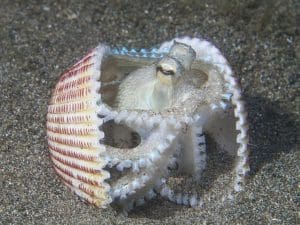
Description of the Absence of a Hard Internal Skeleton in Octopuses:
- Hydrostatic Skeleton: The skeletal structure of octopuses is primarily hydrostatic in nature. This means that their bodies are supported and controlled by the incompressibility of fluids, namely the water-based hemolymph within their bodies. The hemolymph helps maintain the shape and form of the octopus, allowing it to move and change its body shape freely.
- Muscular Hydrostat: The muscles in an octopus’s body, particularly in its mantle and tentacles, play a significant role in maintaining its shape and supporting its movements. These muscular structures are referred to as muscular hydrostats. By contracting and relaxing specific muscles, the octopus can push and pull water in and out of its body cavities, adjusting its buoyancy and moving with impressive fluidity.
Advantages of a Soft and Flexible Body:
- Passing Through Narrow Spaces: The absence of a rigid internal skeleton allows octopuses to contort and squeeze through incredibly tight and confined spaces. This flexibility is advantageous for finding shelter, hiding from predators, and accessing small crevices where prey might be hiding. Their ability to change shape and flatten their bodies also enhances their camouflage abilities, enabling them to blend seamlessly with their environment.
- Enhanced Adaptability: Octopuses’ soft bodies enable them to adapt quickly to changes in their surroundings. Their ability to adjust their body shape allows them to mimic various objects and even other marine creatures, contributing to their incredible camouflage skills and defensive strategies.
- Exceptional Locomotion: With their hydrostatic skeleton and muscular hydrostats, octopuses can move gracefully and efficiently through the water. They use jet propulsion to propel themselves rapidly in the opposite direction of their siphon’s ejection, allowing them to move forward, backward, and laterally with ease.
Reproduction and Life Cycle.🐟
The reproduction and life cycle of octopuses are intriguing and unique processes that showcase the complex strategies these marine creatures employ to ensure the survival of their species. From their intricate mating rituals to the careful nurturing of their eggs, octopuses exhibit fascinating behaviors throughout their life cycle.
Description of Octopus Reproduction and Egg Care:
- Mating Rituals: Octopuses have diverse mating rituals depending on the species. In some cases, males may display elaborate courtship behaviors, involving color displays, posturing, and tactile interactions to attract potential mates. Once a successful mating occurs, male octopuses often transfer a specially modified arm, called a hectocotylus, into the female’s mantle cavity, where it releases spermatophores for fertilization.
- Egg Laying and Nest Building: After mating, female octopuses lay clusters of eggs, typically ranging from hundreds to thousands, depending on the species. They create secure nests or lairs in suitable hiding places, such as rocky crevices or coral formations, to protect the developing eggs from predators.
- Egg Care and Defense: Female octopuses demonstrate exceptional maternal instincts by guarding and tending to their eggs diligently. They actively fan the eggs with their arms to ensure a steady flow of oxygenated water and remove debris or potential threats from the nest. Some species also lay a mucous covering over the eggs, offering additional protection.
- Brooding Period: The brooding period varies depending on the species and environmental conditions, but it generally lasts several weeks to several months. During this time, the female refrains from feeding and focuses entirely on caring for her eggs until they hatch.
Explanation of Octopus Life Cycle and Attainment of Sexual Maturity:
- Egg Hatching: After the brooding period, the eggs hatch, releasing miniature versions of the adult octopuses known as juveniles or paralarvae. These tiny creatures disperse into the water, where they must fend for themselves in the vast ocean.
- Growth and Development: Octopuses undergo rapid growth during the early stages of their life. To sustain this growth, they must actively hunt for prey and avoid predators in their vulnerable state. They possess innate instincts that aid in survival, but learning through experience and trial and error is also crucial during this phase.
- Metamorphosis: As they mature, the juvenile octopuses undergo metamorphosis, where they develop the characteristic features of adult octopuses, including the formation of their eight arms and specialized suckers.
- Maturity and Reproduction: The attainment of sexual maturity varies depending on the species and environmental factors. In general, octopuses reach sexual maturity anywhere from several months to a few years after hatching. Once mature, they engage in the complex courtship and mating rituals, thus completing the life cycle and continuing the cycle of reproduction.

